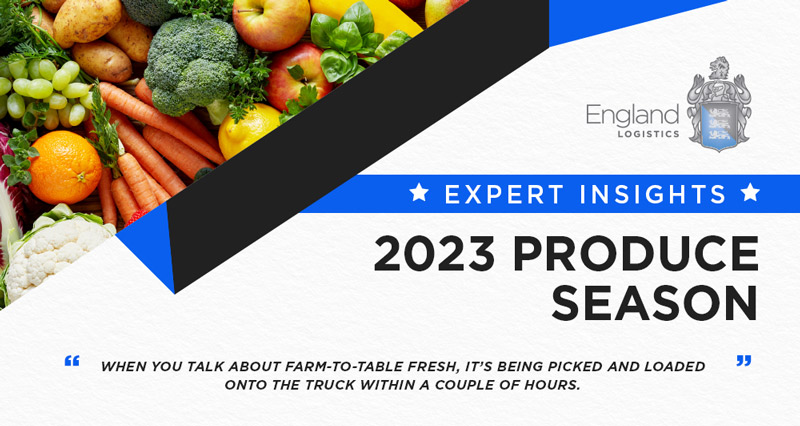![]()
Staying on top of seasonal trends is vital to prepare you for cyclical market shifts. Whether shipping fresh fruits and vegetables or looking for capacity during produce season, it pays to plan ahead. Here is some information to help you get ahead of the rush.
What is Produce Season?
Produce season is a period from late spring through the beginning of summer where a large volume of fruits and vegetables are transported. Produce season peaks between April and July as seasonal produce and fruit are harvested and prepared for shipping. Fresh products need to be moved to grocery stores and vendors, starting in the southern states as temperatures increase and then spreading throughout the country. These shipments are time sensitive due to the limited shelf life of harvest freight. Temperature-controlled trucks are in high demand during this time of year, impacting capacity and shipping rates.
Produce Season by the State
Each region has its peak and most common fruit or vegetable being shipped. Knowing when the areas near you will be at their peak volume is essential. Southern states like Florida kick off the produce season, so keeping up to date on their market conditions can indicate when volume will begin to increase in your area.
Florida produce season peaks between mid-April and July. This follows the tail end of the growing season for oranges, one of the biggest exports in the state. Although oranges begin to ripen in October, the peak season for Valencia oranges is April-July. In the 2022-2023 season, Valencia oranges are projected to make up 17 million of the total 28 million boxes of oranges shipped.
In Southern Texas, produce shippers prepare for a heavy peak from April to July. This period lines up with the beginning of the Hass avocado harvest. It starts in April and can go as late as October. Mexico is a large producer of avocados; much of that freight will move through Texas and be distributed across the rest of the United States.
Hotspots for Produce Season
The two most significant areas for fresh, in-season fruits and vegetable products are the Yuma Valley in Arizona and the San Joaquin Valley in California.
California sees its peak from May to August, overlapping with the table grape season, which runs from May to January, and the beginning of the wine grape harvest from late summer through the winter months. Over 1,250 truckloads per week of table grapes are shipped out of San Joaquin, California. Other notable crops include tomatoes, carrots, and strawberries.
Arizona is also a significant contributor to produce season. Major crops like lettuce, lemons, melons, and grains are grown in the Yuma valley. About 90% of the leafy greens in the United States are grown here, and over 1000 trucks per day load vegetables out of Yuma, Arizona, during the produce season.
Important Dates to Know
One of the most important dates leading up to the start of produce season is the Vidalia Onion “pack date.” These onions are a Georgia staple and state vegetable and are only available for a short time each year. The pack date signals the beginning of the produce shipping season for many other growers and is typically in mid-April. The Vidalia Onion Committee determines the date based on the weather each year. No onions sold before the pack date can be called a Vidalia. Throughout the season, around 200 million pounds of onions will be distributed nationwide.
Before the pack date signal from Georgia, the Plant City Strawberry Festival in Florida is a preliminary sign that produce season is about to begin. This year the festival will be held from March 2 to March 12. The festival celebrates the end of the winter strawberry season, an important contributor to the state’s economy. Each year about 300,000 pounds of strawberries are grown and transported. California still leads the nation in strawberry production, beginning its peak harvest shortly after the festival.
What Makes Produce Season Different?
Some unique factors come into play with shipping fresh produce. Speed and temperature are essential factors in keeping everything fresh in transit. Efficiency is critical to preserving the shelf life of season fruits and vegetables, and each must maintain a specific temperature range to stay fresh. Chad Thomas, England Logistics’ Senior Director of Logistics Services, is eager for the season to begin, “I think what makes it exciting is the ability to preserve the freshness of the product and the quality of the product by being a participant in their supply chain and getting it to the retailer and the consumer as quickly as possible.”
Another aspect of the shipping process that makes moving produce different from other loads is the pickup location. Thomas explains, “When we go out to pick up many of these loads, they are not coming in through warehouses. We are literally driving on to farms and very small produce operations where they are loading the trucks on the field or adjacent to the field. When you talk about farm-to-table fresh, it’s being picked and loaded onto the truck within a couple of hours.”
What to Expect in Produce Season 2023
The market for fresh produce in the United States was valued at 62.52 billion in 2021 and is expected to grow at an annual rate of 5% from 2022 to 2030. This is partially a result of health concerns and a growing preference for fresher and more nutritious food. Consumers are more interested in fresh produce, and this ever-increasing trend has produced a substantial demand for fresh and organic fruits and vegetables. This demand will likely show itself during produce season in 2023.
Another factor impacting produce season this year is the recent weather conditions in California. Large amounts of rainfall will likely affect the harvest of seasonal produce. According to Thomas, “[these growing conditions] could give us one of the best produce harvests we have seen domestically in nearly a decade or more.”
How to Prepare for Produce Season
Whether you are shipping seasonal produce or another refrigerated product, securing capacity during produce season will be easier if plans are made well in advance. Working with a 3PL with access to an extensive network of carriers can help you prepare to move your freight. 3PLs like England Logistics prepare for the produce season by working with shippers and carriers.
Thomas explains that “assessing where the temperature-controlled capacity network stands ahead of the season is so important to offer up that capacity to shippers in their time of need and not come up short.” When working with a 3PL, you will have access to industry experts that are prepared to help you quickly get your loads to their destinations to prevent spoiled products.
Even if you can get the trucks you need, rates will likely be higher during this time. Making plans before the shipping rush can help you avoid some of the spikes in rates that will come at the season’s peak.
Another thing to watch for if you are preparing to ship something other than produce is the peak time for crops in your target areas. Each region will have its spike as the seasonal fruits and vegetables are harvested. Depending on the region, this will happen at different times, so knowing when you will likely experience disruptions and competition for trucks is vital.
Planning is essential to shipping your loads during produce season. Knowing when the season begins and how to determine when and where competition for capacity will occur can help you succeed. Produce has unique needs during transit, and moving loads quickly is crucial. Being prepared and working with a team of industry experts can help you get the most out of produce season.
—
The England Logistics full truckload division offers services for companies of all sizes. Dedicated team members are available day and night to offer solutions and assistance with all logistical needs. Regardless of the transportation mode, our market and seasonal specialists provide flexible shipping solutions and are committed to helping every step of the way.



